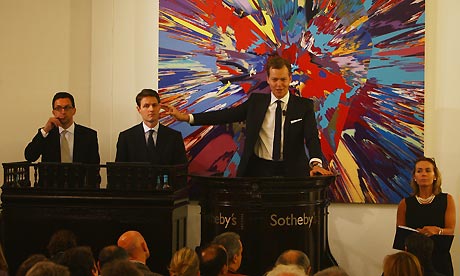
Damien Hurst work being auctioned at Sotheby’s
Here’s a very different take on the intersection of activism and art. Protesters aligned with Occupy Wall Street disrupted an art auction at Sotheby’s, because the company has locked out its art handlers in an attempt to shrink its numbers of unionized workers and curtail benefits — despite record profits. As reported on truth-out.org, a number of activists stood up during the auction and shouted out facts about this unjust lockout, before being escorted out of the building.
Most of the organizing discussed on this site sees art as a vehicle for marginalized voices and social change. But Sotheby’s represents the other side of the art world, and this dispute reminds us that art is not inherently disruptive or radical — it all depends on how it is made and, in this case, how it is understood, bought, and sold. Whatever the original artists had in mind, in the context of Sotheby’s corporate auctions, which sell art to the very rich for extremely high prices, art becomes a commodity and an integral part of both economic and cultural hegemony. Sotheby’s, along with many museums and other elite institutions, takes part in defining what is art, what is “high” art, and what that means in our dominant culture. Art becomes merely a status symbol, part of the cultural capital that seeks to separate classes in our society.
These activists, along with the Teamsters who represent the art handlers, are engaging the economic side of the art world. But spaces like Sotheby’s are also potentially rich sites for cultural organizers who want to disrupt and challenge dominant ideas of what is art and who is an artist. I could see some very creative arts-based actions being taken around auction houses and similarly elite arts spaces. How might we reframe (pun intended) how these spaces and the art within them are understood?



